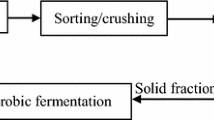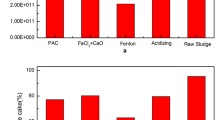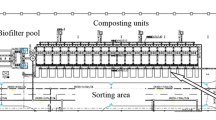Abstract
Disposal of sewage sludge, a by-product of wastewater treatment, is one of the most intractable problems for environmental protection industry. The odorous gases discharged from sludge drying has seriously affected the life quality of residents, causing growing public concern of its odor pollution. The previous studies mainly focused on municipal sludge. In this research, samples of distillery sludge, municipal sludge and pharmaceutical sludge were collected and dried under identical conditions to compare the pollutant release characteristics of municipal sludge and industrial sludge. Throughout the drying process, the amounts of emitted ammonia, hydrogen sulfide and benzene series were detected every 10 min, and the odor pollution of different drying exhaust was quantitatively evaluated using odor threshold. The results of the drying experiments showed that the odor problem of municipal sludge was significantly worse compared to industrial sludge. The maximum odor index during thermal drying of municipal sludge was 15,332, which was 3 times that of distillery sludge and 24 times that of pharmaceutical sludge. The odor pollution caused by benzene series was negligible for any type of sludge, but drying process should be ceased before the moisture content falls to 10% to reduce their carcinogenic risk to exposed individuals.





Similar content being viewed by others
References
Yao T, Wei Y, Zhang J, Wang Y, Yu Y, Huang W (2022) What influences the urban sewage discharge in China? The effect of diversified factors on the urban sewage discharge in different regions of China. Environ Dev Sustain 24(5):6099–6135
Yang G, Zhang G, Wang H (2015) Current state of sludge production, management, treatment and disposal in China. Water Res 78:60–73
Gholipour S, Ghalhari MR, Nikaeen M, Rabbani D, Pakzad P, Miranzadeh MB (2022) Occurrence of viruses in sewage sludge: a systematic review. Sci Total Environ 824:153886
Cunat A, Alvarez-Ruiz R, Suarez-Varela MMM, Pico Y (2022) Suspected-screening assessment of the occurrence of organic compounds in sewage sludge. J Environ Manag 308:114587
Gupta H (2018) PAH determination in effluent and sludge samples of paper industry. Environ Technol Innov 9:115–121
Geng H, Xu Y, Zheng L, Gong H, Dai L, Dai X (2020) An overview of removing heavy metals from sewage sludge: achievements and perspectives. Environ Pollut 266:115375
Li X, Chen L, Mei Q, Dong B, Dai X, Ding G, Zeng EY (2018) Microplastics in sewage sludge from the wastewater treatment plants in China. Water Res 142:75–85
Courtois P, de Vaufleury A, Grosser A, Lors C, Vandenbulcke F (2021) Transfer of sulfidized silver from silver nanoparticles, in sewage sludge, to plants and primary consumers in agricultural soil environment. Sci Total Environ 777:145900
Milojevic N, Cydzik-Kwiatkowska A (2021) Agricultural use of sewage sludge as a threat of microplastic (MP) spread in the environment and the role of governance. Energies 14(19):6293
Yan H, Yin X, Xiao J, Hu Y (2018) Heavy metals concentration of sewage sludge and ecological risk assessment for agriculture in Xuchang City, China. Fresen Environ Bull 27(12):8220–8227
Duan Z, Lu W, Mustafa MF, Du J, Wen Y (2022) Odorous gas emissions from sewage sludge composting windrows affected by the turning operation and associated health risks. Sci Total Environ 839:155996
Xue S, Ding W, Li L, Ma J, Chai F, Liu J (2022) Emission, dispersion, and potential risk of volatile organic and odorous compounds in the exhaust gas from two sludge thermal drying processes. Waste Manag 138:116–124
Gonzalez D, Guerra N, Colon J, Gabriel D, Ponsa S, Sanchez A (2019) Filling in sewage sludge biodrying gaps: Greenhouse gases, volatile organic compounds and odour emissions. Bioresour Technol 291:121857
Galwa-Widera M, Kwarciak-Kozlowska A (2021) Biofiltration - an ecological method of removing odors generated during drying sewage sludge-case study. Desalin Water Treat 232:236–243
Deng W, Yan J, Li X, Wang F, Zhu X, Lu S, Cen K (2009) Emission characteristics of volatile compounds during sludges drying process. J Hazard Mater 162(1):186–192
Weng H, Ji Z, Chu Y, Cheng C, Zhang J (2012) Benzene series in sewage sludge from China and its release characteristics during drying process. Environ Earth Sci 65(3):561–569
Liu W, Xu J, Liu J, Cao H, Huang X, Li G (2015) Characteristics of ammonia emission during thermal drying of lime sludge for co-combustion in cement kilns. Environ Technol 36(2):226–236
Dai Z, Tian L, Liu C, Weng H (2017) Chlorobenzene release during thermal drying of sludge: mechanism and source. Water Air Soil Poll 228(9):368
Horttanainen M, Deviatkin I, Havukainen J (2017) Nitrogen release from mechanically dewatered sewage sludge during thermal drying and potential for recovery. J Clean Prod 142:1819–1826
Wu M, Wang Z, Zhou J, Niu M, Jiang X, Lv Y, Xiao Q, Li G, Wang Y (2018) Release characteristics and control of hydrogen sulfide during thermal drying of municipal wastewater sludge. J Mater Cycles Waste 20(2):946–954
Guo Y, Qiu X, Li N, Feng S, Cheng T, Liu Q, He Q, Kan R, Yang H, Li C (2020) A portable laser-based sensor for detecting H2S in domestic natural gas. Infrared Phys Techn 105:103153
Zheng F, Qiu X, Shao L, Feng S, Cheng T, He X, He Q, Li C, Kan R, Fittschen C (2020) Measurement of nitric oxide from cigarette burning using TDLAS based on quantum cascade laser. Opt Laser Technol 124:105963
Lan L, Ghasemifard H, Yuan Y, Hachinger S, Zhao X, Bhattacharjee S, Bi X, Bai Y, Menzel A, Chen J (2020) Assessment of urban CO2 measurement and source attribution in Munich based on TDLAS-WMS and trajectory analysis. Atmosphere-Basel 11(1):58
Shi Z, Sun X, Lu Y, Xi L, Zhao X (2019) Emissions of ammonia and hydrogen sulfide from typical dairy barns in central China and major factors influencing the emissions. Sci Rep-Uk 9:13821
Mackie RI, Stroot PG, Varel VH (1998) Biochemical identification and biological origin of key odor components in livestock waste. J Anim Sci 76(5):1331–1342
Hu R, Liu G, Zhang H, Xue H, Wang X, Lam PKS (2020) Odor pollution due to industrial emission of volatile organic compounds: a case study in Hefei, China. J Clean Prod 246:119075
Leonardos G, Kendall D, Barnard N (1969) Odor threshold determination of 53 odorant chemicals. J Air Pollut Control Assoc 19(2):91–95
Yoshio N (2003) Measurement of odor threshold by triangle odor bag method. Odor Meas Rev 118:118–127
Wang G, Zhai Z, Geng J, Han M, Lu F (2015) Determination of odor threshold of 40 typical malodorous substances (in Chinese). J Saf Environ 15(6):348–351
Hellman TM, Small FH (1974) Characterization of the odor properties of 101 petrochemicals using sensory methods. J Air Pollut Control Assoc 24(10):979–982
Dhote L, Mandpe A, Paliya S, Kumar S, Pandey RA, Kumar R (2020) Characterization of distillery sludge for its thermal properties and ascertaining its utilization as a low-cost fuel. J Clean Prod 259:120872
Chengyin Y, Yang C, Kun O, Jiangfeng Y, Jinping L (2018) Current research situation and prospect of ammonia nitrogen wastewater treatment technology. Ind Water Treat 38(3):1–5
Song Y, Woo J, Oh G, Kim D, Lee C, Kim H (2021) External electric field promotes ammonia stripping from wastewater. Water Res 203:117518
Weng H, Dai Z, Ji Z, Gao C, Liu C (2015) Release and control of hydrogen sulfide during sludge thermal drying. J Hazard Mater 296:61–67
Reiffenstein R, Hulbert W, Roth S (1992) Toxicology of hydrogen sulfide. Annu Rev Pharmacol 32(1):109–134
Liu S, Wei M, Qiao Y, Yang Z, Gui B, Yu Y, Xu M (2015) Release of organic sulfur as sulfur-containing gases during low temperature pyrolysis of sewage sludge. P Combust Inst 35(3):2767–2775
Wang G, Wei W, Mi TQ, Wang PT, Li S (2015) Characteristics of VOCs emitted from typical industrial fugitive. Environ Sci 35(7):1957–1964
Ruiz-Munoz A, Siles JA, Marquez P, Toledo M, Gutierrez MC, Martin MA (2022) Odor emission assessment of different WWTPs with extended aeration activated sludge and rotating biological contactor technologies in the province of Cordoba (Spain). J Environ Manag 326:116741
Bylinski H, Barczak RJ, Gebicki J, Namiesnik J (2019) Monitoring of odors emitted from stabilized dewatered sludge subjected to aging using proton transfer reaction-mass spectrometry. Environ Sci Pollut R 26(6):5500–5513
Avili RG, Takdastan A, Atabi F, Omrani GA (2021) Investigating the reduction of BTEX in automotive paint sludge combined with biological sludge by vermicomposting process using Eisenia fetida. Environ Eng Manag J 8(2):87–94
Acknowledgements
This study was supported by Science and Technology Plan Project of Zhejiang Province (No. 2021C03162)
Funding
Science and Technology Plan Project of Zhejiang Province, No. 2021C03162, Fei Wang, National Key R&D Program of China, No. 2019YFC1907000, Fei Wang, National Nature Science Foundation of China, No. 51976188, Fei Wang.
Author information
Authors and Affiliations
Corresponding author
Ethics declarations
Conflict of interest
The authors declare that they have no known financial or interpersonal conflicts that would have appeared to have an impact on the research presented in this study.
Additional information
Publisher's Note
Springer Nature remains neutral with regard to jurisdictional claims in published maps and institutional affiliations.
Rights and permissions
Springer Nature or its licensor (e.g. a society or other partner) holds exclusive rights to this article under a publishing agreement with the author(s) or other rightsholder(s); author self-archiving of the accepted manuscript version of this article is solely governed by the terms of such publishing agreement and applicable law.
About this article
Cite this article
Bao, B., Wang, F. Hazardous emission from thermal drying of municipal sludge and industrial sludge as well as associated odor pollution. J Mater Cycles Waste Manag 25, 2187–2194 (2023). https://doi.org/10.1007/s10163-023-01675-y
Received:
Accepted:
Published:
Issue Date:
DOI: https://doi.org/10.1007/s10163-023-01675-y




